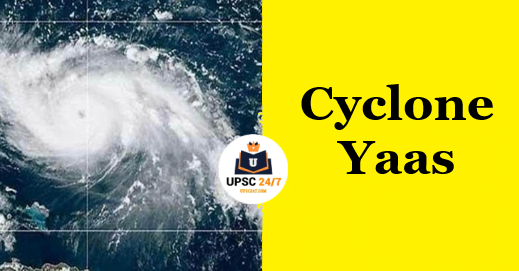Cyclone Yaas UPSC | Bay Of Bengal Cyclone Yaas | Types Of Cyclones – The India Meteorological Department (IMD) has informed that a low pressure area is formed over north Andaman Sea and adjoining east central Bay of Bengal around May 22. It is likely to intensify into a cyclonic storm by May 24. It has been named as Cyclone Yaas. In May 2021, another cyclonic storm named ‘Cyclone Tauktae’ had affected the Indian states of Kerala, Gujarat, Maharashtra, Goa and Karnataka, along with two Union Territories: Daman & Diu and Lakshadweep.
Key Facts About Cyclone Yaas
| What type of cyclone is Yaas? | Cyclone Yaas has been classified as a ‘Very Severe Cyclonic Storm (VSCS)’ |
| What is the meaning of the word ‘Yaas’? | The word has originated from the Persian language and mean ‘Jasmin’ in English |
| Which country has named the Cyclone, Yaas? | The cyclone has been named Yaas by Oman |
| Indian States expected to be affected | West Bengal, Orisha, Assam and Meghalaya |
| How are cyclones named? | 13 countries of the World Meteorological Organization/United Nations Economic and Social Commission for Asia and the Pacific (WMO/ESCAP) Panel on Tropical Cyclones (PTC) name the cyclones |
| Next Cyclone Name Will Be | The next cyclone—after Yaas—is likely to be named Gulab, suggested by Pakistan. |
- The cyclone is expected to make landfall somewhere between Paradip (Orisha) and Sagar islands (West Bengal) on the evening of May 26, 2021
- It has originated from the East-central Bay of Bengal

The Indian Meteorological Department (IMD) has issued rainfall warning in the following regions:
-
- North Coastal Andhra Pradesh
- Odisha
- West Bengal and Sikkim
- Jharkhand
- Bihar
- Assam and Meghalaya
How Are Cyclones Formed For UPSC
Regional names of cyclone
|
How does a cyclone form?
- Cyclones are formed in the low-pressure area.
- The topography and the intensity as well as frequency of cyclones that could strike a coast decide the vulnerability of the place.
- The temperature difference between the warm, rising and the cooler environment led to the rise of air to become buoyant and then moves to upward.
- Then the high-pressure area fills the air in the low-pressure area.
- This cycle continues as warm air rises and a low-pressure area filled with cool air.
- They build up over a period of time.
- The warm, moist air rises and cools the water in the air and forms clouds.
- The whole system of clouds and wind spins and grows, fed by the ocean’s heat and water evaporating from the ocean surface.
Project Dantak UPSC | UPSC Current Affairs & Quiz
There are six factors responsible for the formation of the cyclone:
- Sufficient warm temperature at sea surface
- Atmospheric instability
- Impact area of Coriolis force so that low pressure can be developed
- High humidity in the lower to middle levels of the troposphere
- A pre-existing low-level focus or disturbance (6) low vertical wind shear.







